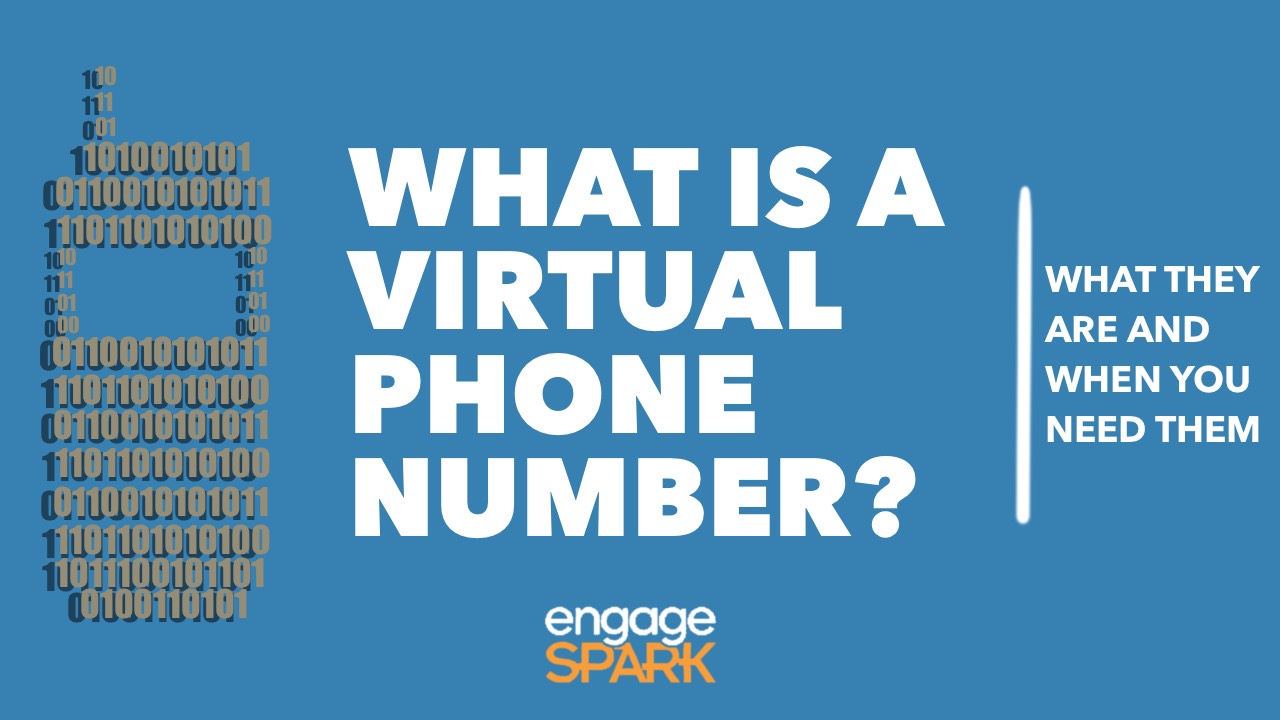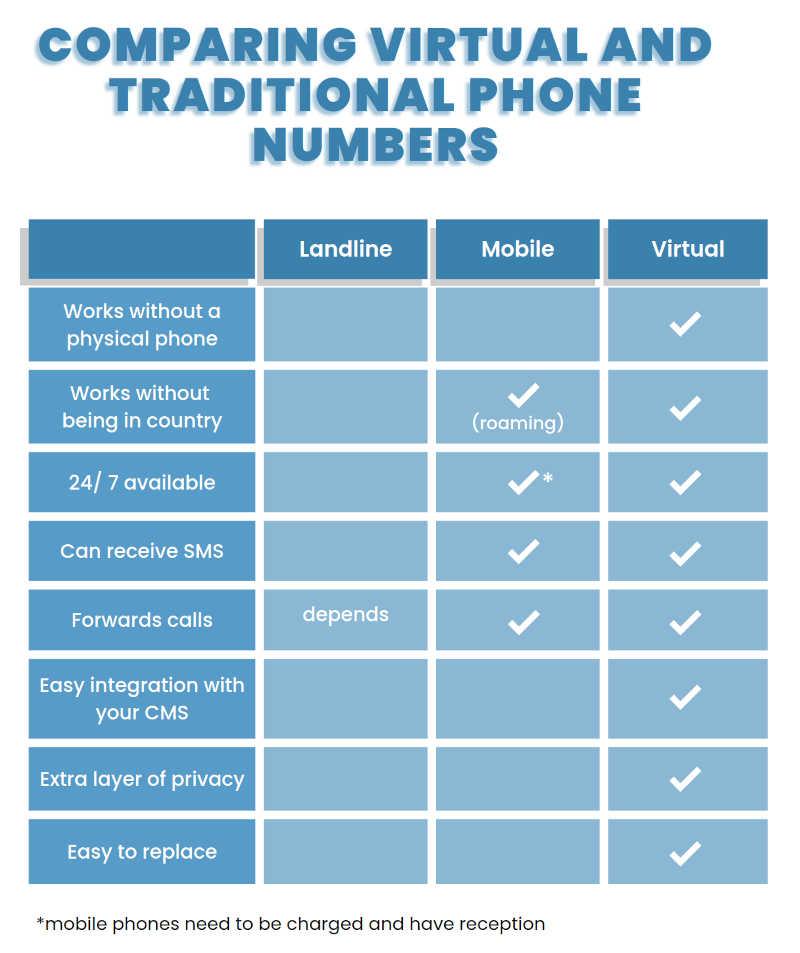What is a Virtual Phone Number? (And How They Work)

Virtual phone numbers are flexible numbers where you decide what happens to incoming SMS and calls. Also called “DID“—short for “direct inward dialing“ (numbers)—virtual numbers give you full control because they are not associated with a single phone line.
Have you ever used Google Voice or called a Skype number? Then you’re already familiar with the topic! Both companies are virtual phone number providers.

Virtual numbers can look like normal numbers: They may have a local area code, so they might look like a local number from Washington DC, perhaps, or like a local number from Nairobi, Kenya, if that’s where you need a business phone number. Alternatively, they will look like mobile numbers. Availability depends on the regulations in each country.
They can behave like normal numbers, too: People can call or message them as usual—but you as the owner of the number decide what happens next. You can connect calls to a landline, to a mobile phone—or even to a computer system. That is how the age-old phone system gets a bit of “magic”.Here are other things you can do:
- run automated mobile surveys using your choice of SMS, Voice IVR, or WhatsApp
- forward SMS to your email inbox or your mobile phone
- attach a voicemail that uses speech recognition to send you a transcript
- and much more—see below
In other words, virtual phone numbers do for the phone system what email did for the postal service: they remove unnecessary attachment to a physical location or phone—and unleash the full potential of the internet.
How to Use Virtual Phone Numbers
So, what kind of organization can use a virtual phone number … and for what?
Business phone numbers
- Easy example: forward calls that reach your business phone number: During the work day you might forward incoming calls to your desk phone at the office. After business hours, callers using the same number might end up talking to you on your cell phone—and they’ll never know the difference.
- Use your business phone number for marketing campaigns. For example, tell people to do a missed call and automatically gather the phone numbers for a raffle the next day. (This actually isn’t hard to do: You could for instance insert them in a Google spreadsheet using Zapier.)
- Collect sales leads: Connect the number with your CRM and automatically create prospects for every incoming SMS or call, adding the phone numbers for quick call backs.
- Shield your cell phone: Use your virtual phone number for your business and forward calls to your cell phone. If you ever need to, it’s easy to replace your virtual number—and no one will get your private number without your consent.

Business Example: Employee Attendance Hotline, Philippines
House of IT, an Australian BPO, set up an attendance hotline on the engageSPARK platform.
Employees then could text for free to report that they’ll be late or absent, reducing excuses like “no load”, “no airtime”, or “no internet connection”. Managers and HR get notified instantly of an employee’s absence or lateness.
Read more about how House of IT used three virtual phone numbers to manage employee absenteeism.
For Research Universities and Institutes
- Large-scale demographic surveys with SMS: For any sort of large-scale demographic SMS Survey you need a number to send text messages from and where people reply to.
- Advertise surveys for airtime (topup): Advertise virtual numbers for surveys where participants receive an airtime incentive for successful survey completion. Read about how we can help you with Airtime top-ups.
NGOs and social enterprises
- Toll-free phone number for surveys: Make cost a non-issue by using toll-free numbers that program participants can make phone calls to. An automated IVR system might then answer the call with a voice survey.
- Opt-in to social intervention programs: Allow citizens all over the country of your choice to jump onboard using only their mobile devices—with either SMS, phone calls, or WhatsApp.
Example: WhatsApp Survey of Migrants, Senegal
The International Organization for Migration (IOM) surveyed migrants using audio clips on WhatsApp.
How do you scale WhatsApp Surveys? First, you register a WhatsApp Business phone number, which allows you to send pre-approved conversation starters (“template messages“) to other, personal WhatsApp accounts.
Read more about why IOM used audio clips instead of text messages for their WhatsApp survey.
Comparing Virtual and Traditional Phone Numbers
Why not just stick with a good old landline? You can—if you don’t need what a virtual phone system has to offer you. Have a look at the following table that compares landlines, mobile phones, and virtual phone numbers in terms of features and possibilities offered.

Note that you can do some things using traditional phone numbers. For example, your telco provider might allow you to use your mobile phone in other countries using roaming, or apps on your smartphone might enable you to forward calls. However, those solutions are often clumsy and expensive.
For simple use-cases it may be all you need, so its worth checking out.
Common Features of Virtual Phone Numbers
What you can do with a virtual number depends on a the country and the virtual phone system of the provider. Here are a few features you might encounter or look for:
- SMS-enabled: Your number can receive SMS.
- MMS-enabled: Your number can receive SMS.
- Voice-enabled: Your number can receive incoming calls—and for example send them to a voice mail, or hang up and call right back. (This is a “missed call subscription“).
- WhatsApp-enabled: Can be used for your WhatsApp business account—you can then use it to reach out to people using template messages, or respond to inquiries.
- Call forwarding: Forward calls to another number. Depending on your provider, you can configure rules based for example on your business hours. Call forwarding is often supported by a traditional business phone system with a physical phone or by mobile apps on a smartphone—but you with a virtual phone number you don’t need either to avail this feature!
- Call recording: Automatically record an incoming call for auditing or coaching purposes.
- Toll-free: Such a number is free to message or call—you’re picking up the bill for it. (See below)
- REST API call backs: Depending on the virtual phone system, you might send HTTP call backs to your CRM or ATS.
- Answer calls with a Voice IVR Survey
- Charge customers for services: some providers allow you to charge customers money when they text you. This is often seen with short codes (see below)
7 US Virtual Phone Number Providers
So, where can you get your hands on one of those numbers? There are a lot of companies out there, catering to personal-use numbers, or specializing on virtual business phone numbers, so it may be hard to choose.
However, to get you started for the common US case, here are a couple of well-known virtual phone number providers, where you can easily buy phone numbers for the United States.
- Google Voice
- MagicJack—well known provider for virtual business phone numbers
- RingCentral
- Skype
- Twilio
- Vonage (acquired Nexmo a while back)
- Zoom
Are you interested in virtual phone numbers in emerging or developing markets? Check out what we at engageSPARK can offer you.
How much does a virtual phone number cost?
Usually, a virtual phone number requires a one-time setup fee as well as a monthly fee. Furthermore, you may be charged for inbound SMS or phone call minutes.
That said, costs vary widely between countries, carriers and providers, so make sure you get information for the country you need the numbers in. To give you ballpark numbers for March 2022:
- Germany, SMS-enabled: $5 setup, $50 / month
- Kenya, voice-enabled: $100 setup, $40 / month
- United States, SMS & Voice enabled: no setup fee, $5 / month
What other fees and requirements exist?
As far as other, non-financial requirements go, it’s hard to make a general statement.
At times, nothing is required. At other times, you need to have a local presence in the country. (See below.) In extreme cases you must have a business permit to claim a local business phone number.
Other restrictions may apply. In China, for example, individuals cannot buy DIDs.
If you require virtual phone numbers for surveys, research, or 2-way campaigns, particularly in developing or emerging markets, reach out to our friendly support team.
What is a short code, and is it different from a local virtual number?
Short codes are SMS- or MMS-enabled numbers, usually without a local area code. They are meant to be memorable, and are often used for marketing campaigns and charity projects.
Short numbers, as they are also called, are usually virtual numbers and can offer a variety of features, such as reverse charges, for example to collect donations.
When a virtual number is not short, it’s often referred to as a long code. In that case, it looks like a local phone number.
What are toll-free numbers and when do you need one?
A toll-free number is like any other virtual number with one big difference: you can message or call them for free! Of course, someone needs to cover the costs and that is the owner of the number. Why would you possibly want to do that?

Let’s say, you want to encourage customers to give you feedback using a quick SMS Survey. You keep it short because few people are taking the time anyway. But then there is the issue of cost: even fewer people want to pay to give you feedback. That’s when you might decide: I’ll pay for SMS.
How much do you pay for each incoming SMS or call minute? The costs vary widely and depend both on the country and the provider. If you’re wondering if toll-free virtual phone numbers are available in your country, reach out to our friendly support team.
One thing to watch out for: Toll-free numbers aren’t available everywhere and they aren’t always cheap. There is much more to say about free-to-message numbers … which we’ll cover in a future article.
Frequently Asked Questions
Virtual phone numbers seem straightforward… until you get into the details. In the following we’re trying to answer the most common questions we’ve encountered.
Do you need a physical address to claim local phone numbers?
The specific requirements for a virtual phone number (including long codes with a local area code) depend on the regulations in each country. Sometimes, there are no requirements at all, and sometimes it’s very strict.
For example, if you want to buy a local Belgian number, you are required to provide a proof of address of that locality or region.
Make sure you check the requirements before going ahead with your marketing campaign or business program.
Can you get custom numbers?
It depends on the carrier and provider. In some countries, providers have reserved batches of numbers so they allow you to search for available numbers with certain sequences.
For example, in the US it’s often possible to get long codes that contain desired sequences.
Since short-codes are meant to be memorable and are usually not cheap, it is more common to be able to pick & choose numbers as they are available.
What are 2-way SMS numbers?
2-way SMS numbers are another term for virtual phone numbers that are SMS-enabled. Their name emphasizes that SMS can be both sent and received.
Two-way SMS, i.e. SMS going both ways, is crucial to running SMS Surveys or SMS opt-in campaigns, which is why we have a separate article just about them.
Can people from outside the country call or text your virtual number?
It depends. Some providers support this, some don’t, and in some countries it’s not even allowed.
How long does it take to register a virtual phone number?
That depends a lot on the country.
In some—the US for instance—a number can be provided in minutes, whereas in other countries it can take days or even weeks.
You can expect delays if you require custom sequences in your virtual phone number, for example if you want the number to contain 283651, because that’s your business name on a keypad.
Can you use a virtual phone number for WhatsApp Business?
Yes, you can.

Read this blog post how IOM used their WhatsApp Business account for a survey.
Can you use a virtual phone number to activate a WhatsApp account?
Yes, you can!
Check out this Quora post for more info.
Can you use these numbers to divert calls to your mobile phone?
Yes!
This is call forwarding and a common feature of virtual phone numbers.
Can you use a virtual phone number for SMS verification?
Yes, though some providers may be restricted.
Can you use a virtual phone number for OTP?
Yes, you can use virtual phone numbers to receive SMS-based one-time passwords (OTP).
However, there are a few things you should consider:
- Make sure you get a number from a country that the app or service accepts.
- Some providers might not work. For example, some services reject Google Voice for OTP.
Is a virtual number usable as a caller ID?
Yes, you can use it as a caller ID.
This helps in two ways:
- People can save your number in their address book, so they know it’s a trusted number.
- When they miss the call and see it on their mobile later, they can call you right back.
What about using it as a sender ID for SMS?
Yes—if your number is SMS-enabled, i.e. supports sending and receiving text messages.
Note that when using a virtual phone number as sender ID, you are allowing contacts to reply—but the SMS are not branded. In turn, if you decide to use a branded sender ID, for example your organization’s name, then your name will appear as the sender—but people cannot directly reply to the message.
Read more about the different kinds of sender and caller IDs here.
Are virtual phone numbers legal?
Some people wonder about the meaning of “virtual“. Are those numbers even legal? Are they maybe fake?
We can assure you that virtual phone numbers are a legal feature of phone systems all over the world, including the US and Europe. They’ve been around for decades.
Of course, you still need to follow local laws and regulations concerning spam, DNC lists, robo calls, etc.
What’s the difference between VOIP, SIP, and virtual phone numbers?
VOIP is an umbrella term for a basket of technologies that allow phone calls to be made over the internet. It’s short for “Voice over IP“.
One of these technologies is SIP, short for Session Initiation Protocol. It is used to control calls—i.e. making calls, adding conference participants, and hanging up calls. A SIP address is similar to a traditional phone number—but like an email it includes a domain, pointing to the provider.
A VOIP provider offers part of this technology stack, and yes, a VOIP provider might offer virtual phone numbers.
Inbound Rules: How to send SMS or make API requests for incoming calls with engageSPARK
Once you have a virtual phone number, it’s time to start using it. For example, you might want to:
- send yourself an SMS whenever you receive calls.
- forward each SMS that contains the word “buy“ or “order“ as an email to your virtual assistant, who then processes the order.
- Create a customer in SalesForce for every incoming WhatsApp message.
But how?
This really depends on the provider of the number, but in a shameless plug we can share how you’d do it with us—on the engageSPARK platform. The following video will give you a very short intro to “inbound rules“ and how you can use your virtual number to do all the above, and more.

